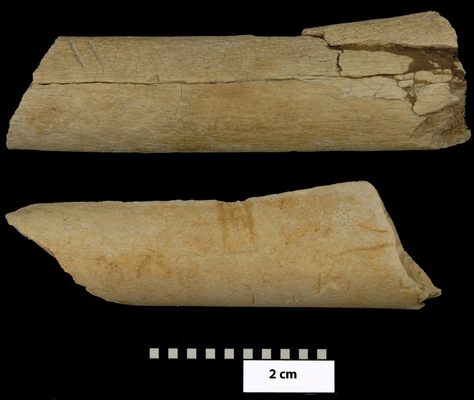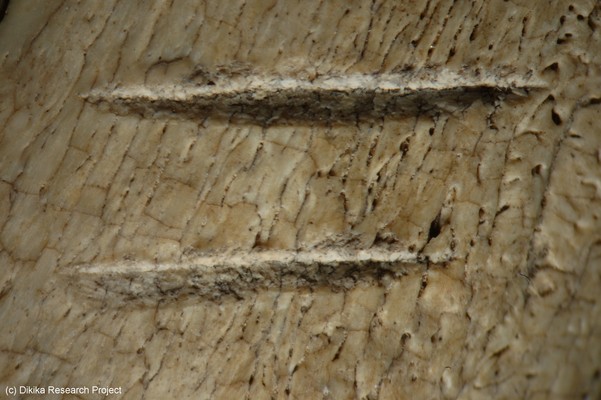
by Nicole Branan Thursday, January 5, 2012

Possibly stone tool-modified bones from Dikika, Ethiopia. Dikika Research Project

Two parallel cut marks possibly made by stone tools cutting into tissues on the rib of a cow-sized or larger ungulate. Dikika Research Project
The debate over when our ancestors first used stone tools is not over just yet. In August, researchers had reported finding scratch marks on two 3.4-million-year-old animal bones that they said were made by Australopithecus afarensis — the ancestor made famous by Lucy — scraping meat off the bones with sharp-edged stones. If true, that would push tool use back to 800,000 years earlier than previously thought. However, a new study challenges this interpretation and says that the marks were not made by early humans, but came instead from sediments grinding against the surface of the bones.
Shannon McPherron, a Paleolithic archaeologist at the Max Planck Institute for Evolutionary Anthropology in Leipzig, Germany, and his team found the bones in question in the Dikika area in Ethiopia. In August, McPherron and his team authored a paper in Nature stating that the marks resemble butchery cuts.
But figuring out what caused scratch marks on fossil animal bones is a tricky issue, says Henry Bunn, a paleoanthropologist at the University of Wisconsin at Madison and a member of the team criticizing the initial study. Both hominin butchery and trampling — either from animals stepping on bones or from sediments grinding against them — can cause deep grooves and fine scratches on bones, he says. However, experiments with modern bones have enabled scientists to distinguish between those types of cuts — for example, Bunn says, V-shaped marks are characteristic of stone tool use, while trampling causes more rounded grooves.
Bunn and his colleagues say the marks on the 3.4-million-year-old bones resemble the types of damage characteristic for trampling. “It’s almost like a mirror image; the similarities are striking,” Bunn says. Bunn and his team also considered evidence other than the actual marks on the bones. For example, no sharp-edged stones were found at the Dikika site, they wrote in the Proceedings of the National Academy of Sciences. That makes it hard to explain how hominins could have produced stone tool marks. “There are no bigger pieces of stone that would be graspable by a hominin, whether we are talking about intentionally produced flakes or naturally broken but unmodified pieces of rock,” Bunn says.
Another issue is the exact location where the bones came from, Bunn says. The team working at Dikika found the specimens on the surface and only know approximately which layer of sediment they were originally buried in. That matters because the type of sediment can determine whether trampling damage was even possible. “Did the bones originate in a very fine clay deposit, in which case there would be no natural sediments coarse and abrasive enough to cause the damage, or did the bones occur in a sandy deposit?” Bunn says. He and his team would like to see the Dikika research project team follow up by establishing where the bones came from and then excavating there.
The fact that Bunn and his team did not examine the actual bones, and instead based their analysis on the scanning electron microscope images published in the Nature paper, also makes their characterization of the marks difficult, McPherron says. “One of the issues that [Bunn and his team] raise is whether or not the marks have a V-shape to them and it’s obviously hard to show V-shapes in a photo,” McPherron says.
Richard Potts, a paleoanthropologist at Smithsonian’s National Museum of Natural History and the Human Origins Program in Washington, D.C., who was not involved in either study, agrees that additional evidence, such as the type of sediment and the presence of sharp stones, is important. “I would say that you need four things to make the extraordinary case of [stone tool use] 800,000 years earlier: sediments, tools, bones with marks on them, in the ground and in the same place.”
The answer to the question of whether the marks are actually butchery marks is unclear, Potts says. “What’s coming out from this [controversy] is that you can get two very good research groups who have been leaders in the field of identifying damage to fossil bones …. and they disagree. That basically says that the criteria for recognizing and distinguishing these kinds of marks are not as yet good enough.”
© 2008-2021. All rights reserved. Any copying, redistribution or retransmission of any of the contents of this service without the expressed written permission of the American Geosciences Institute is expressly prohibited. Click here for all copyright requests.